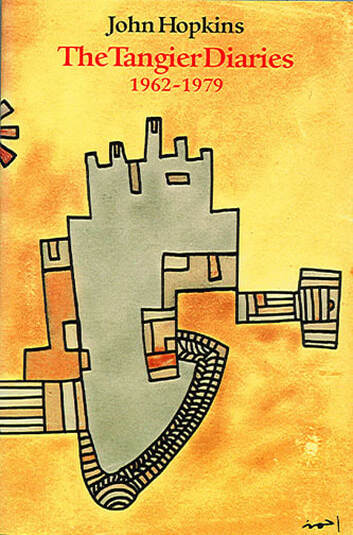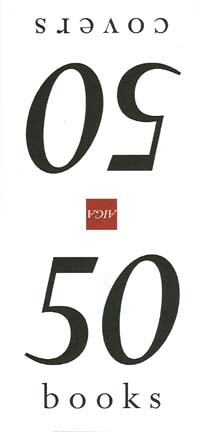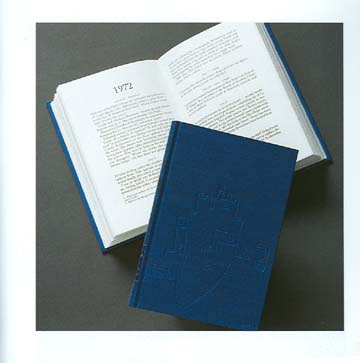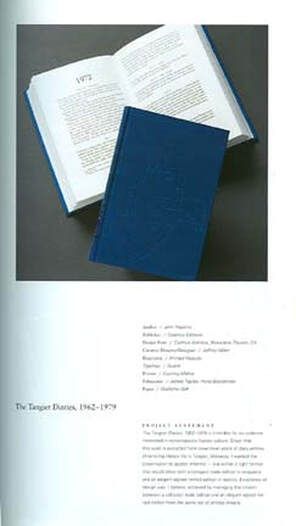|
Diary entries chosen from a decade and half's worth give us an extraordinarily vivid portrait of Tangier, presenting a huge and dizzying cast of writers, painters, socialites, trance dancers, eccentrics, party-givers, magicians, aristocrats, confidence men and expat residents from the early sixties through the late seventies. Paul Bowles on The Tangier Diaries: “It's a beautiful work and I am only sorry that it's not longer. I'd be exceedingly proud to have written it.” William Burroughs has also weighed in with a trenchant opinion: “Every page drips with memories.” The American Institute of Graphic Arts
50 covers 50 books of 1998 Cloth cover embossed with
Ahmed Yacoubi's illustration Graphic Design USA: 20
|
The Tangier Diaries, 1962 – 1979
by John Hopkins Cover illustration by Ahmed Yacoubi Including photos by Robert Freson and Cherie Nutting First English language edition 1998 First published by La Table Ronde, Paris, 1995 251 pages + 8 photo pages on coated stock, 4½" x 7" ISBN 0-932274-50-1 Rights Reverted Princeton grad John Hopkins came to Tangier after adventures in Peru, a stint reading to the blind novelist, Percy Lubbock, on the Golfo de la Spezia, and a motorcycle trip from Munich to Mombasa, to take up a job at the American School of Tangier. In addition to the portraiture of the city and its inhabitants, John Hopkins' life in Marrakech and his trips on camel into Morocco's Sahara, plus his travels to Algeria, Tunisia, Libya, Spanish Sahara, Mauretania, Senegal, Ghana, Nigeria, Togo, Cameroun, Swaziland and Mozambique are chronicled in entries rich with detail.
Along the way Hopkins tells us how he found his vocation as novelist in the midst of all the excitement of living in Tangier and befriending so many Tangerines and those who passed through its purlieus. The glamour, mystery, poverty and opulence of Tangier, the country of Morocco and Africa jumps from every page, with occasional brief asides in Amsterdam, Salamanca, Paris, and New York. In choice entries tout Tanger comes suddenly to life: In sharp but sympathetically observed portraits one encounters Paul and Jane Bowles, Barbara Hutton, William Burroughs, Brion Gysin, Princess Ruspoli, Malcolm Forbes, Tennessee Williams, Mohammed M1rabet, The Hon. David Herbert, Ira Bilankine, Ted Morgan, The Countess de Breteuil and her fabulous mud castle in Marrakech, The Lady Caroline Duff, Jim Wyllie, Elizabeth Vreeland, Jean Genet, Elizabeth David, Alec Waugh, Alfred Chester, Margaret Lane, Louise de Meuron, Adolfo de Velasco, Marguerite McBey and countless others plus a host of people who floated through Tangier and Marrakech, during that bright period—from Vera Stravinsky to the fabled Arabian explorer, William Thesiger; Yves St. Laurent, Timothy Leary, Saul Bellow, The Beatles, Estelle Parsons, Josephine Baker, Angus Wilson, Paul Getty, Irene Pappas, Rudolph Nureyev and Geoffrey Wolff. The diaries come to an end after Hopkins' marriage to Ellen Ann Ragsdale in Tangier's St. Andrews Church when they decide to raise a family in England, and Hopkins says his fond farewells to his many friends, Morocco, and its hospitable people—that special place where he lived for so long and became a writer. The Tangier Diaries will be invaluable for anyone interested in Tangier and the myriad writers and artists who have lived there. Photo insert includes photography never before published—including work by Ira Cohen, Cherie Nutting, Dfuf, Abdelouhid Boulaich, Brahim ben Abdelrahman, and Tessa Codrington. Hopkins is the author of five novels including Tangier Buzzless Flies and In the Chinese Mountains. About the Book . . . a great, outlandish American Bloomsbury. Hopkins delivers all the expected goodies and more: the requisite desert meditations, the kif-censed evenings in the kasbah, the celebrity sightings. Beyond the usual literary suspects such as his friends Paul and Jane Bowles and William Burroughs, we have everyone from Malcolm Forbes to Tennessee Williams to the Beatles. — Kirkus Reviews . . . . During his time in Morocco, Hopkins managed to enter into two major romances, befriend fellow ex-pat novelists William Burroughs and Paul Bowles, and even write several novels. As Hopkins gains experience, the voice he uses to catalogue his life in Tangier changes, from his first perceptions as a perpetual tourist . . . to an insider's appreciation of the land and the culture . . . These musings . . . give the book some of the quality of an 18th century travelogue . . . PUBLISHERS WEEKLY These Tangier Diaries offer a vivid picture of those years which followed the war in a city of relaxed morals where all was for sale, bodies and palaces, where death by overdose prowled. . . . — Michel Mohrt, in "Carte Blanche" MINUTE, Paris . . . a veritable Who's Who of hipness. A 1998 winner of the coveted BookPage "I-read-it-in-one-sitting-because-I-couldn't-put-it-down" award. — Bruce Tierney BOOKPAGE In Hopkins' Diaries, the 60s are described by a young American who surged out of Princeton with a friend to Peru, Europe, and eventually on to Tangier. They bought a BMW motorcycle, named her the White Nile, and plunged into the exotic, sometimes squalid world centered on writers Paul and Jane Bowles. It's fun meeting up with the celebrities—Bellow, Burroughs, Nureyev, and the Beatles 'flat on their backs' at a party, but this is, above all, a literary journal in which Hopkins records his apprenticeship as a novelist and conveys 'the sheer glory and joy of being alive in this town.' A hit! — Nancy Good SUNDAY MAIL An unexpected treasure, Hopkins settles in Tangier and makes friends with Jane and Paul Bowles, William Burroughs, Brion Gysin and all the other expatriates. His accounts of his regular meetings with them adds greatly to our knowledge . . . a search for meaning in life in a culture that nearly forty years ago was almost like another planet. — Kevin Ring BEAT SCENE “She radiated a kind of twisted, broken beauty,” is how John Hopkins remembers Jane Bowles in . . . The Tangier Diaries. Although Bowles is only one of a huge cast of characters—her husband Paul Bowles, William Burroughs, Brion Gysin, Mohammed M'rabet, Larby Layachi, Alfred Chester, Timothy Leary, and Tennessee Williams are just some of the others—she is a frequent touchstone for the young Hopkins, her deterioration and death offering a kind of shape to his diaristic account. The 1975 entry headed “Looking for Jane Bowles' Grave” is an especially moving one, a climax which seems to lead the maturing writer toward his eventual departure from the once magical Interzone. While occasionally self-indulgent as diaries can be, this first-hand account is a marvelous book, a portrait not only of life in Tangier but of the metamorphosis Hopkins underwent from Rimbaudian adventurer to ordinary human being. — Eric Lorberer RAIN TAXI Paul Bowles casts a long shadow over most writing about Morocco being done in English, so it's rare to find an original voice that casts the country and its people in the kind of light that approximates the intense sunshine that caresses the beach under Cap Spartel. John Hopkins is an American novelist who arrived in Tangier in the early 60s and stayed long enough to see how things changed . . . My favorite sections of the diaries contain a portrait of Tangier after the Beatniks left and the hippies arrived, a city with a louche population of expats . . . Hopkins also gives us priceless vignettes of Bowles, Brion Gysin and the rest of that wonderful gang, and seems to have a great deal of fun doing it. One of the best books about Morocco in years. — Stephen Davis THE BEAT, v. 17, #6 The Tangier Diaries transports the reader to a unique time and place populated by many of the artisitic and social notable of our time. At once a coming of age story and a chronicle of "literary Tangier", these entries paint sharp, but sympathetically observed, portraits of Paul & Jane Bowles, Barbara Hutton, William Burroughs, Brion Gysin, Malcolm Forbes, Tennessee Williams, Ted Morgan, Vera Stravinsky, Yves St. Laurent, Wilfred Thesiger, Josephine Baker, Paul Getty, Rudolph Nureyev, and many others. MIDWEST BOOK REVIEW -INTERNET BOOKWATCH: April 1998 REVIEWER'S CHOICE — James A. Cox, Editor-in-Chief - Diane Donovan, Editor MIDWEST BOOK REVIEW These fascinating pages which trek invincibly from one year to the next are crammed with the gliterazia who once made up Tangier society . . . Wilfred Thesiger, the Arab traveller, Josephine Baker, Yves St. Laurent are just a few of the personalities who make these pages crackle with life. Gossip, intrique, or the extremes of native wealth and poverty are recorded with unerring skill until, quite honestly, you find yourself carrying the book to the dentist, the doctor's waiting room or the supermarket queue, unable to rest until you've finished it. There's very little you can do with a journal as subtly disturbing as this one except read it . . . His book is filled with the mysteries of humankind—their sanity, their excesses and their endless fight to hold on to what they believe themselves. They bitch endlessly, they die, they stay alive for another party—another endless lunch in the Tangier sun. — Richard Edmonds BIRMINGHAM POST [U.K.] Tangier has been a magnet for eminent diarists including Samuel Pepys, Cecil Beaton and Joe Orton: Hopkins is a worthy addition to this list. The rich and the famous figure prominently in Hopkins' account but his particular charm is his reticence. In an age when steamy revelations have become a publishing requisite, he averts his gaze . . . His gentlemanly code ensures that, for once, Barbara Hutton isn't derided for her promiscuity and prodigality but, rather, celebrated in buying a house for a friend. During these years, Hopkins published his first two novels and the diary is, above all, an account of his literary development and of the celebrated writers he meets . . . Paul and Jane Bowles are the presiding geniuses of the diary: All lovers of The Sheltering Sky will be grateful for this intimate record of Paul's methods and opinions, while the most poignant sections are reserved for the report of a visit to a dying Jane in a Spanish clinic and his return, years later, to trace her unmarked grave. Hopkins writes as powerfully of places as of people, capturing the steamy bustle of the medina market and the awesome mystery of the Sahara. It is not, however, a book for the squeamish. Lizards and scorpions wriggle through its pages, while there are more snakes than in “Indiana Jones and The Temple of Doom." — Michael Arditi DAILY MAIL [U.K.] With The Tangier Diaries, longtime Morocco habitué John Hopkins, an American novelist and inveteratge wanderer, has produced a lively and intimate portrait of this unique time and place in the form of his own journals from that era. Tennessee Williams and beat heroes William S. Burroughs and Brion Gysin appear often as well, and Samuel Beckett, Saul Bellow, Alec Waugh and many other authors also crop up. The international jet set also frequented Tangier, including the Beatles . . . J. Paul Getty, Timothy Leary, Anthony Quinn and a host of others, all attending a seemingly endless round of decadent parties given by the likes of Malcolm Forbes and Barbara Hutton. The contrast between these glamorous figures and the baking, dusty, malodorous and often menacing local setting is striking. The shouting and haggling, the flies and confusion, the sickly-sweet smell of uncollected garbage: it was a scene to send tourists home in strait-jackets. Like Paul Bowles and others who made Morocco their home, he is enchanted with the impenetrable mystery of the place, and with the vast desert and sky just south of Tangier. Such contrasts among the gossip and intrigue of famous personages, Hopkins' own inner journey and the exotic setting are what make “the cosmic and minute conclusions” of The Tangier Diaries such an engrossing read. Hopkins' diaries move gradually from the naïve and even trite observations of a young would-be writer to a more mature account of the tragic decline of Jane Bowles . . . Fortunately, these diaries survived to provide a fascinating glimpse of a unique time and place in modern literary history. — Steve Hellig THE SAN FRANCISCO CHRONICLE BOOK REVIEW I read The Tangier Diaries in a rush and I was mesmerized. There is such intensity of thought and feeling in those sentences. Hopkins writes prose that has brilliant intensity of feeling and understanding, sensual seriousness. From that episode with the Greek painter in Pete's Tavern in '59, when Hopkins decides to become a writer, there follows a logic like the immutable logic of faith and I utterly believe in his belief, and in the cost of it. Hopkins is an unusual man with an unusual mind; the ferocity of his will to get deep into something that matters, together with his courage, quotidian, in the face of risk as well as intellectual—has left an extraordinary record in this book. The book's intensity is from an earlier time—Bowles and Bowles and Burroughs—and from a different geography. There's something brand-new in his descriptions of the oldest things: thick mud walls, dunes, the sea, snakes, the dome of the sky. It's as though he's willing to wear his nerves outside of his skin. And for all that precision and narrative economy, his accounts of characters have great warmth. My whole admiration for this book and for the wholesome passion that made it possible. — Geoffrey Wolff also by John Hopkins
The South American Diaries |
Cadmus Editions
jeffcadmus@aol.com
jeffcadmus@aol.com




